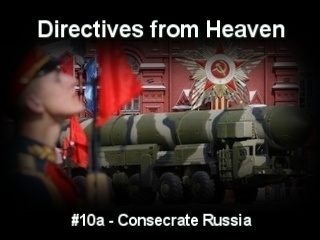|
Home - Latest News |
Introduction |
Bayside Messages |
Directives from Heaven |
Testimonies |
Veronica Lueken |
Miraculous Photos |
Videos |
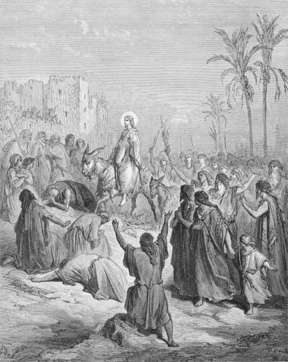 Lenten
readings Lenten
readings
Palm Sunday meditation
"Why must you insult My Son? Can you
not bend your knees? Is He not your King?" - Our Lady of the Roses, November
21, 1970
"The lessons of your Faith have been
given to you for all time without change. My Son is forever, for God is, God
was, and God always will be. My Son is your God in the Father and the Holy
Ghost. Do not cast aside your knowledge in faith of the Trinity. Do not cast
aside your knowledge in faith of My Son's divinity. Do not recrucify My Son upon
your earth and in His Church, His House. You call upon you a heavy hand of
punishment from the Eternal Father!" - Our Lady of the Roses, December 24,
1976
|
A meditation on Lent from The Liturgical Year by Abbot Dom Guéranger,
O.S.B.
Early in the morning of this day, Jesus sets out for
Jerusalem, leaving Mary His Mother, and the two sisters Martha and Mary
Magdalene, and Lazarus, at Bethania. The Mother of sorrows trembles at seeing
her Son thus expose Himself to danger, for His enemies are bent upon His
destruction; but it is not death, it is triumph, that Jesus is to receive today
in Jerusalem. The Messias, before being nailed to the cross, is to be proclaimed
King by the people of the great city; the little children are to make her
streets echo with their Hosanna to the Son of David; and this in presence of the
soldiers of Rome's emperor, and of the high priests and pharisees: the first
standing under the banner of their eagles; the second, dumb with rage.
The prophet Zachary had foretold this triumph which the
Son of Man was to receive a few days before His Passion, and which had been
prepared for Him from all eternity. ' Rejoice greatly, O daughter of Sion! Shout
for joy, O daughter of Jerusalem! Behold thy King will come to thee; the Just
and the Saviour. He is poor, and riding upon an ass, and upon a colt, the foal
of an ass.' [Zach. ix. 9.] Jesus, knowing that the hour has come for the
fulfilment of this prophecy, singles out two from the rest of His disciples, and
bids them lead to Him an ass and her colt, which they would find not far off. He
has reached Bethphage, on Mount Olivet. The two disciples lose no time in
executing the order given them by their divine Master; and the ass and the colt
are soon brought to the place where He stands.
The holy fathers have explained to us the mystery of these
two animals. The ass represents the Jewish people, which had been long under the
yoke of the Law; the colt, upon which, as the evangelist says, no man yet hath
sat, [St. Mark xi. 2.] is a figure of the Gentile world, which no one had ever
yet brought into subjection. The future of these two peoples is to be decided a
few days hence: the Jews will be rejected, for having refused to acknowledge
Jesus as the Messias; the Gentiles will take their place, to be adopted as God's
people, and become docile and faithful.
The disciples spread their garments upon the colt; and our
Saviour, that the prophetic figure might be fulfilled, sits upon him, [Ibid. 7,
and St. Luke xix. 35.] and advances towards Jerusalem. As soon as it is known
that Jesus is near the city, the Holy Spirit works in the hearts of those Jews,
who have come from all parts to celebrate the feast of the Passover. They go out
to meet our Lord, holding palm branches in their hands, and loudly proclaiming
Him to be King. [St. Luke xix. 38.] They that have accompanied Jesus from
Bethania, join the enthusiastic crowd. Whilst some spread their garments on the
way, others cut down boughs from the palm-trees, and strew them along the road.
Hosanna is the triumphant cry, proclaiming to the whole city that Jesus, the Son
of David, has made His entrance as her King.
Thus did God, in His power over men's hearts, procure a
triumph for His Son, and in the very city which, a few days later, was to
clamour for His Blood. This day was one of glory to our Jesus, and the holy
Church would have us renew, each year, the memory of this triumph of the
Man-God. Shortly after the birth of our Emmanuel, we saw the Magi coming from
the extreme east, and looking in Jerusalem for the King of the Jews, to whom
they intended offering their gifts and their adorations: but it is Jerusalem
herself that now goes forth to meet this King. Each of these events is an
acknowledgment of the kingship of Jesus; the first, from the Gentiles; the
second, from the Jews. Both were to pay Him this regal homage, before He
suffered His Passion. The inscription to be put upon the cross, by Pilate's
order, will express the kingly character of the Crucified: Jesus of Nazareth,
King of the Jews. Pilate, the Roman governor, the pagan, the base coward, has
been unwittingly the fulfiller of a prophecy; and when the enemies of Jesus
insist on the inscription being altered, Pilate will not deign to give them any
answer but this: ' What I have written, I have written.' Today, it is the Jews
themselves that proclaim Jesus to be their King: they will soon be dispersed, in
punishment for their revolt against the Son of David; but Jesus is King, and
will be so for ever. Thus were literally verified the words spoken by the
Archangel to Mary, when he announced to her the glories of the Child that was to
be born of her: ' The Lord God shall give unto Him the throne of David, His
father; and He shall reign in the house of Jacob for ever.' [St. Luke i. 32.]
Jesus begins His reign upon the earth this very day; and though the first Israel
is soon to disclaim His rule, a new Israel, formed from the faithful few of the
old, shall rise up in every nation of the earth, and become the kingdom of
Christ, a kingdom such as no mere earthly monarch ever coveted in his wildest
fancies of ambition.
This is the glorious mystery which ushers in the great
week, the week of dolours. Holy Church would have us give this momentary
consolation to our heart, and hail our Jesus as our King. She has so arranged
the service of today, that it should express both joy and sorrow; joy, by
uniting herself with the loyal hosannas of the city of David; and sorrow, by
compassionating the Passion of her divine Spouse. The whole function is divided
into three parts, which we will now proceed to explain.
The first is the blessing of the palms; and we may have an
idea of its importance from the solemnity used by the Church in this sacred
rite. One would suppose that the holy Sacrifice has begun, and is going to be
offered up in honour of Jesus' entry into Jerusalem. Introit, Collect, Epistle,
Gradual, Gospel, even a Preface, are said, as though we were, as usual,
preparing for the immolation of the spotless Lamb; but, after the triple
Sanctus! Sanctus! Sanctus! the Church suspends these sacrificial formulas, and
turns to the blessing of the palms. The prayers she uses for this blessing are
eloquent and full of instruction; and, together with the sprinkling with holy
water and the incensation, impart a virtue to these branches, which elevates
them to the supernatural order, and makes them means for the sanctification of
our souls and the protection of our persons and dwellings. The faithful should
hold these palms in their hands during the procession, and during the reading of
the Passion at Mass, and keep them in their homes as an outward expression of
their faith, and as a pledge of God's watchful love.
It is scarcely necessary to tell our reader that the palms
or olive branches, thus blessed, are carried in memory of those wherewith the
people of Jerusalem strewed the road, as our Saviour made His triumphant entry;
but a word on the antiquity of our ceremony will not be superfluous. It began
very early in the east. It is probable that, as far as Jerusalem itself is
concerned, the custom was established immediately after the ages of persecution.
St. Cyril, who was bishop of that city in the fourth century, tells us that the
palm-tree, from which the people cut the branches when they went out to meet our
Saviour, was still to be seen in the vale of Cedron. [Cateches. x. versus fin.]
Such a circumstance would naturally suggest an annual commemoration of the great
event. In the following century, we find this ceremony established, not only in
the churches of the east, but also in the monasteries of Egypt and Syria. At the
beginning of Lent, many of the holy monks obtained permission from their abbots
to retire into the desert, that they might spend the sacred season in strict
seclusion; but they were obliged to return to their monasteries for Palm Sunday,
as we learn from the life of Saint Euthymius, written by his disciple Cyril.
[Act. SS. Jan. 20.] In the west, the introduction of this ceremony was more
gradual; the first trace we find of it is in the sacramentary of St. Gregory,
that is, at the end of the sixth, or the beginning of the seventh, century. When
the faith had penetrated into the north, it was not possible to have palms or
olive branches; they were supplied by branches from other trees. The beautiful
prayers used in the blessing, and based on the mysteries expressed by the palm
and olive trees, are still employed in the blessing of our willow, box, or other
branches; and rightly, for these represent the symbolical ones which nature has
denied us.
The second of today's ceremonies is the procession, which
comes immediately after the blessing of the palms. It represents our Saviour's
journey to Jerusalem, and His entry into the city. To make it the more
expressive, the branches that have just been blessed are held in the hand during
it. With the Jews, to hold a branch in one's hand was a sign of joy. The divine
law had sanctioned this practice, as we read in the following passage from
Leviticus, where God commands His people to keep the feast of tabernacles: And
you shall take to you, on the first day, the fruits of the fairest tree, and
branches of palm-trees, and boughs of thick trees, and willows of the brook, and
you shall rejoice before the Lord your God. [Lev. xxiii. 40.] It was, therefore,
to testify their delight at seeing Jesus enter within their walls, that the
inhabitants, even the little children, of Jerusalem, went forth to meet Him with
palms in their hands. Let us, also, go before our King, singing our hosannas to
Him as the conqueror of death, and the liberator of His people.
During the middle ages, it was the custom, in many
churches, to carry the book of the holy Gospels in this procession. The Gospel
contains the words of Jesus Christ, and was considered to represent Him. The
procession halted at an appointed place, or station: the deacon then opened the
sacred volume, and sang from it the passage which describes our Lord's entry
into Jerusalem. This done, the cross which, up to this moment, was veiled, was
uncovered; each of the clergy advanced towards it, venerated it, and placed at
its foot a small portion of the palm he held in his hand. The procession then
returned, preceded by the cross, which was left unveiled until all had
re-entered the church. In England and Normandy, as far back as the eleventh
century, there was practised a holy ceremony which represented, even more
vividly than the one we have just been describing, the scene that was witnessed
on this day at Jerusalem: the blessed Sacrament was carried in procession. The
heresy of Berengarius, against the real presence of Jesus in the Eucharist, had
been broached about that time; and the tribute of triumphant joy here shown to
the sacred Host was a distant preparation for the feast and procession which
were to be instituted at a later period.
A touching ceremony was also practised in Jerusalem during
today's procession, and, like those just mentioned, was intended to commemorate
the event related by the Gospel. The whole community of the Franciscans (to
whose keeping the holy places are entrusted) went in the morning to Bethphage.
There, the father guardian of the holy Land, being vested in pontifical robes,
mounted upon an ass, on which garments were laid. Accompanied by the friars and
the Catholics of Jerusalem, all holding palms in their hands, he entered the
city, and alighted at the church of the holy sepulchre where Mass was celebrated
with all possible solemnity.
This beautiful ceremony, which dated from the period of
the Latin kingdom in Jerusalem, has been forbidden for now almost two hundred
years, by the Turkish authorities of the city.
We have mentioned these different usages, as we have done
others on similar occasions, in order to aid the faithful to the better
understanding of the several mysteries of the liturgy. In the present instance,
they will learn that, in to-day's procession, the Church wishes us to honour
Jesus Christ as though He were really among us, and were receiving the humble
tribute of our loyalty. Let us lovingly go forth to meet this our King, our
Saviour, who comes to visit the daughter of Sion, as the prophet has just told
us. He is in our midst; it is to Him that we pay honour with our palms: let us
give Him our hearts too. He comes that He may be our King; let us welcome Him as
such, and fervently cry out to Him: 'Hosanna to the Son of David!'
At the close of the procession a ceremony takes place,
which is full of the sublimest symbolism. On returning to the church, the doors
are found to be shut. The triumphant procession is stopped; but the songs of joy
are continued. A hymn in honour of Christ our King is sung with its joyous
chorus; and at length the subdeacon strikes the door with the staff of the
cross; the door opens, and the people, preceded by the clergy, enter the church,
proclaiming the praise of Him, who is our resurrection and our life.
This ceremony is intended to represent the entry of Jesus
into that Jerusalem of which the earthly one was but the figure--the Jerusalem
of heaven, which has been opened for us by our Saviour. The sin of our first
parents had shut it against us; but Jesus, the King of glory, opened its gates
by His cross, to which every resistance yields. Let us, then, continue to follow
in the footsteps of the Son of David, for He is also the Son of God, and He
invites us to share His kingdom with Him. Thus, by the procession, which is
commemorative of what happened on this day, the Church raises up our thoughts to
the glorious mystery of the Ascension, whereby heaven was made the close of
Jesus' mission on earth. Alas! the interval between these two triumphs of our
Redeemer are not all days of joy; and no sooner is our procession over, than the
Church, who had laid aside for a moment the weight of her grief, falls back into
sorrow and mourning.
The third part of today's service is the offering of the
holy Sacrifice. The portions that are sung by the choir are expressive of the
deepest desolation; and the history of our Lord's Passion, which is now to be
read by anticipation, gives to the rest of the day that character of sacred
gloom, which we all know so well. For the last five or six centuries, the Church
has adopted a special chant for this narrative of the holy Gospel. The
historian, or the evangelist, relates the events in a tone that is at once grave
and pathetic; the words of our Saviour are sung to a solemn yet sweet melody,
which strikingly contrasts with the high dominant of the several other
interlocutors and the Jewish populace. During the singing of the Passion, the
faithful should hold their palms in their hands, and, by this emblem of triumph,
protest against the insults offered to Jesus by His enemies. As we listen to
each humiliation and suffering, all of which were endured out of love for us,
let us offer Him our palm as to our dearest Lord and King. When should we be
more adoring, than when He is most suffering?
These are the leading features of this great day.
According to our usual plan, we will add to the prayers and lessons any
instructions that seem to be needed.
This Sunday, besides its liturgical and popular
appellation of Palm Sunday, has had several other names. Thus it was
called Hosanna Sunday, in allusion to the acclamation wherewith the Jews
greeted Jesus on His entry into Jerusalem. Our forefathers used also to call it
Pascha Floridum, because the feast of the Pasch (or Easter), which is but
eight days off, is today in bud, so to speak, and the faithful could begin from
this Sunday to fulfil the precept of Easter Communion. It was in allusion to
this name, that the Spaniards, having on the Palm Sunday of 1513, discovered the
peninsula on the Gulf of Mexico, called it Florida. We also find the name of
Capitilavium given to this Sunday, because, during those times when it was
the custom to defer till Holy Saturday the baptism of infants born during the
preceding months (where such a delay entailed no danger), the parents used, on
this day, to wash the heads of these children, out of respect to the holy chrism
wherewith they were to be anointed. Later on, this Sunday was, at least in some
churches, called the Pasch of the competents, that is, of the
catechumens, who were admitted to Baptism; they assembled today in the church,
and received a special instruction on the symbol, which had been given to them
in the previous scrutiny. In the Gothic Church of Spain, the symbol was not
given till today. The Greeks call this Sunday Baïphoros, that is,
Palm-bearing.
Christ's
Passion as seen and experienced by Veronica (March 8, 1971)
The Passion was seen in vision by Veronica during the praying of the
Sorrowful Mysteries of the Rosary. Present during this phenomenon were Camille
Debrowski, Ben and Mary Salomone, and Evelyn Murphy.
Veronica received the stigmata of the hands and feet at this time. A cross
appeared on her right foot in the instep area, directly in line with the big toe
and second toe, near the center of the instep, but over more to her left side of
the instep, centered between the ankle area and toes. The nail bruise appeared
on the instep of the left foot, more centered between the second and third toe
from the large toe, at the center of the instep. The right foot was crossed over
the left. The cross fitted perfectly in line with the nail mark on the left
foot.
The Passion as related by Veronica:
"Jesus started by requesting that on the three initial beads of the Rosary
we say the Acts of Faith, Hope, and Charity. Then we entered into the Sorrowful
Mysteries.
THE AGONY IN THE GARDEN
"During the first decade I saw Jesus on His knees, bent over in anguish,
praying. He was wearing a long, burgundy-colored cape over an inner garment of
beige-colored material, long and flowing. There was a great sadness in His face,
great sorrow. He was talking to His Father in Heaven:
"'Father, I will drink of this cup, down to the last dreg, if it be Your
will. It is not I that should seek that this cup be removed from Me. My strength
is everlasting in the light, and My heart a bleeding vessel for this cup.'
THE SCOURGING
"During the second Mystery, I cried out, 'No! No! Stop that!' For there was
our beloved Jesus being pulled to and fro as His tormentors pulled His upper
garment from His back. They tied His wrists together and drove a spike into an
upright beam. Jesus' hands were bound by strips of a brown, leather-like cord.
Then the central part of the cord that bound His hands was looped over the spike
in the beam. Poor Jesus was pinned by His hands.
"There were five people in this cave-like room that appeared to be dug out
of a hillside, a sort of hole-room in the hillside.
"I screamed and winced as two soldiers took turns hitting Jesus' bare back
with a long brown, leather-like strap. On this strap were metal hooks, laid
horizontally all along the strap. These nail-like, claw-like fixtures on the
strap cut and scratched deeply into Jesus' flesh, causing blood to pour out. It
was a despicable game with the soldiers. They laughed and joked. Jesus never
said a word.
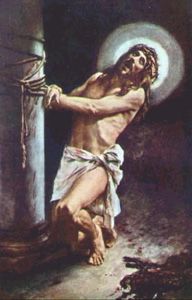 "I cried, 'Say
something! Say something!' He could save Himself, but Jesus remained silent as
they spat and insulted Him. His back became a mass of welts and torn flesh.
Jesus was barefoot; His sandals had fallen off as they banged a stake higher
into the pole and raised poor Jesus up so His toes barely touched the floor. The
floor was just dirt and blood. The soldier remarked, 'Maybe they cut out His
lying tongue. Ha, ha!' Our poor Jesus remained silent.
"I cried, 'Say
something! Say something!' He could save Himself, but Jesus remained silent as
they spat and insulted Him. His back became a mass of welts and torn flesh.
Jesus was barefoot; His sandals had fallen off as they banged a stake higher
into the pole and raised poor Jesus up so His toes barely touched the floor. The
floor was just dirt and blood. The soldier remarked, 'Maybe they cut out His
lying tongue. Ha, ha!' Our poor Jesus remained silent.
"Off to the side I saw a room. There was a large, kettle-like pot, real old
looking--of rough metal, a deep reddish-brown in color, very large. Underneath
was a fire burning; there was a heavy liquid bubbling. Off to the side was
another, longer metal receptacle filled with water. There were two soldiers
dressed in short dresses--short, knee-length skirts, with pointed metal pieces
hanging down in a pattern of triangles all around the waist, front and back.
"They had a metal, vest-like covering on their chests and silver-colored
metal headpieces that were shaped like a cap, but swooped up to a flowing design
on the top. Three other men were almost naked, dressed in diaper-like clothing.
They were holding a long piece of metal. They placed the end in the large
kettle; it had a red-hot glow. Then the third man had a large, mallet-like
hammer, and he beat on the hot metal. He was pounding it round and round until
it looked like a spike. He would then douse it in that metal water trough. Two
soldiers were talking over at the side. Later they took the five spikes. (There
were five large spikes made.)
THE CROWNING WITH THORNS
"I then saw Jesus. He had been cut from the post and had fallen over. A
soldier roughly pulled Him over to a wicker-like stool and plunked Jesus onto
it. Poor Jesus hung forward, and a nasty soldier put a long stick in His hands
to balance Him up, and yelled, 'Ha, ha! So this is the King of the Jews! Let's
dress Him as fitting!'
"The soldier went outside, to return with an armful of brier bush. He used
the metal tongs to make it easier to handle. He made a sort of cap and stuffed a
circlet of briers into it. In that way he could handle it better and shove it on
poor Jesus' head. The thorns were too hard to weave, to stay together, so the
cap was thought of. It was so big, and he kept batting it down with a stick. The
sadist gloated as he swung. Jesus, dearest Savior, said never a word. The pain
was excruciating. Tears coursed down the cheeks of our poor Jesus, but they were
of sorrow. The greatest pain was in His heart!
"Jesus' hands were tied again with the brown, leather-like material; and He
was dragged to His feet. The soldier draped His top gown over His torn back. Oh,
I could see it stick to His oozing blood. Oh, it was horrible!
THE CARRYING OF THE CROSS
"Then a soldier pushed Jesus out of the hole-like entrance, and down a
road. There were many people, all in a spirit of carnival. Two soldiers pushed
Jesus over to the side of the big crossbeam which was carried through the crowd.
It looked like a heavy log--real rough, and a brownish wood. Two soldiers stood
it up and another put Jesus over to it. Two soldiers started to tie His hands
onto it. It was supported across His back and on the shoulders. It looked
awfully heavy and awkward. The brown leather rope was taut across His elbow
area. He seemed to be balancing and supporting the beam as He struggled on.
"There were three ladies and a man walking off to one side with Him. The
ladies were weeping silently. The man had his arm about a lady. The man was very
tall. He had a long, brown gown on, and he had a brown beard and dark brown
hair. The ladies wore beige-colored gowns; but one lady had a purple, coat-like
garment over hers.
"Jesus tripped and fell. He was so weak now, the beam had thrown Him off
balance as He staggered. Poor Jesus fell. One nasty old man ran out of the crowd
to spit and kick Him--the nasty old beast! I tried to tear off my tunic to wipe
the blood out of His eyes. It was awful! He looked up at me--the soldiers
wouldn't let me through. I pulled at my hair in frustration and anguish. Jesus
looked at me, and I saw the love of an eternal, glorious promise. I cried, 'What
could I do?' I screamed, 'Help Him! Help Him, please!' I, Veronica, was helpless
to lift the cross. I could only hope to wipe His dear face.
"Soon a soldier grabbed a man out of the crowd. This man had a long gown on
with stripes down the front, and he had a turban wrapped around his head with
stripes in the front. He sure didn't want to carry the beam, but they knew Jesus
couldn't make it to the outskirts of the town. So this man shouldered the beam
while the insane crowd taunted. Jesus was pushed and pulled along. Dirt and
blood were all over Him; He was a picture of bloody grime.
"I was retching; I was sick. Oh, such a horror! Such torture! How could
they do this to Him? What did He do but love everyone! Beasts! Beasts! Soon the
soldier ran up with the five spikes. When they reached the hill, there was a
long piece of wood already on the ground. A soldier lifted the beam from the
shoulders of this other man and threw it to the ground. Two other soldiers
placed it on top of the long piece of wood to form a cross--long all the way
down, and sort of sticking out at the top. They slammed one spike into the two
beams and the cross was made.
 THE
CRUCIFIXION
THE
CRUCIFIXION
"Two lousy soldiers threw Jesus to the ground, and they pulled His arms out
to stretch across the cross beam. Oh, how it hurt, the back so torn! I could see
the pain in Jesus' eyes, but He never uttered a word. He just looked sad. Then
they took brown, leather-like cord and wrapped it around His wrists at the
board, bound to the board. Then they lifted and tied the wrists to the board,
bound and wound the leather cord around the ankles and the wood to hold Him in
place.
"Then the spikes were thrown onto the ground, and one soldier got down on
his knees and he placed the spike in the center of the palm of poor Jesus' hand.
With that metal mallet he drove it in through the skin and out into the board. I
screamed! I threw up! This was repeated on the right hand. Then Jesus looked up
to the sky. They started on the legs--one large spike into both feet, His right
foot over the left, at a twisted sort of angle, placed to lie flat against each
other. I retched as I heard the metal against flesh and bone and wood. One spike
protruded out the other side. They hammered a block of wood under His poor feet,
'to line 'em up,' they said. It was awful!
"I looked off into the crowd. Oh, there were only nine people there to stay
with Jesus. I now knew His Mother, Mary Cleophas (the wife of Clopas), Mary
Magdalen, and John. Oh, poor Jesus--never a word did He say as they nailed Him
to the wood. Oh, such love!
"Soon two soldiers lifted the head of the wood and three the bottom,
carrying Jesus on the cross, and dropped the end into a hole. It went in with a
thump! Jesus winced. And it tore His hands more. Blood was trickling down His
face. He couldn't move His head. The pain was awful; each movement cut deep. He
sagged a bit, but pulled upward. The sagging tore more.
"Mary and Mary ran up to Him. They did not speak at first; they could talk
with their eyes to each other. They didn't need words. John came over, for
Jesus' bottom tunic fell down. Oh, dear, He was almost naked. I turned away, but
John ran over and tied sort of knots in it, like a diaper. Oh, the humiliation
to poor Jesus! Then Jesus said to John: "Behold, John, your Mother. And this,
Mother, is Your son. I must go to the Father soon."
"The crowd started to move off. Jesus cried: "Abba, abba sabba la bec tori"--that
is what it sounded like--a foreign sound. Sabba sabba sabba la bec tori. (I
can't spell it well, just by sound.) Then He looked up. "I thirst!" (This I
heard in English.)
". . . Water, yellowish water. . . . Jesus' head hung down to His right. It
became dark, so dark. Everyone went away but the nine. They all came close; and
Mary clung to His feet, wordless in sorrow."
 Veronica finished the recitation of what she experienced to find her feet
swollen and her arms sore, the feet marked and the hands stinging. Her wordless
reaction was a mixture of wonder, joy, and love--joy that now she could join
Jesus in His suffering and hold His hand on the road to the Kingdom.
Veronica finished the recitation of what she experienced to find her feet
swollen and her arms sore, the feet marked and the hands stinging. Her wordless
reaction was a mixture of wonder, joy, and love--joy that now she could join
Jesus in His suffering and hold His hand on the road to the Kingdom.
Directives
from Heaven
D1
-
The Holy Sacrifice of the Mass
 PDF
PDF
D2
-
The Holy Eucharist  PDF
PDF
D66
-
The Passion of Christ (Part 1)
 PDF
PDF
D67
-
The Passion of Christ (Part 2)
 PDF
PDF
D87
-
Divinity of Jesus Christ  PDF
PDF
D119
-
Jesus Christ, Redeemer  PDF
PDF
D120 -
Resurrection  PDF
PDF
D198
-
Kneel
Before Your God
 PDF
PDF
D292 -
Way of
the Cross
 PDF
PDF
Videos online:
| Home |
Introduction |
Bayside Messages |
Directives from Heaven |
Miracles & Cures | Veronica Lueken |
Miraculous Photos |
Videos |
Revised:
February 26, 2012
Lenten readings


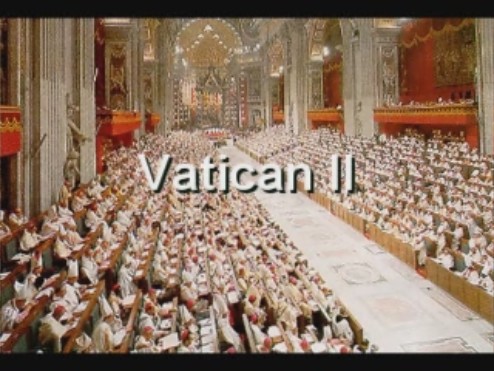 Vatican
II
Vatican
II World
Monetary Crash
World
Monetary Crash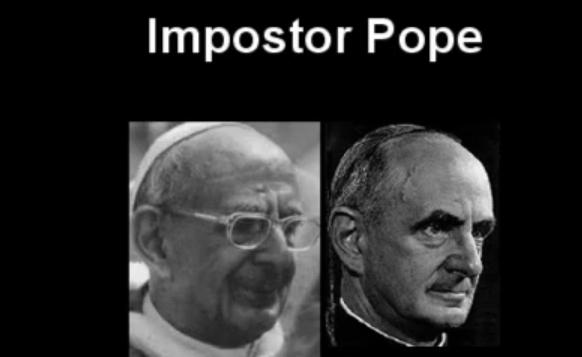 Deception
of the Century
Deception
of the Century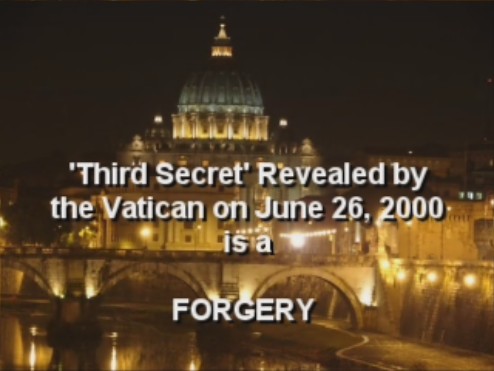 Third
Secret Fabrication
Third
Secret Fabrication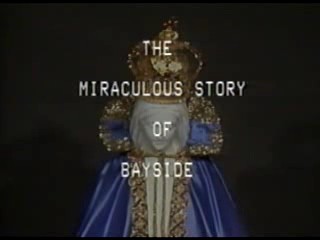 The
Miraculous Story of Bayside
The
Miraculous Story of Bayside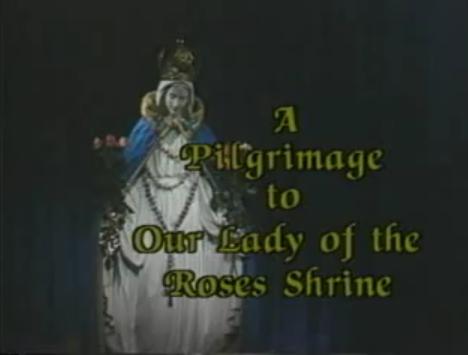 A
Pilgrimage to Our Lady of the Roses Shrine
A
Pilgrimage to Our Lady of the Roses Shrine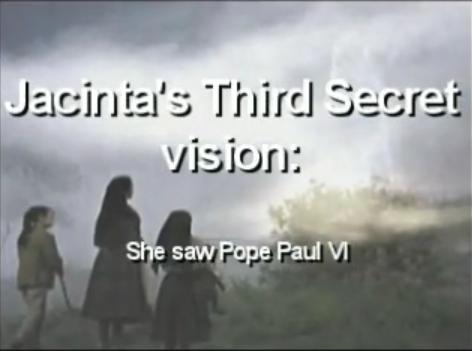 Jacinta's
Third Secret vision: She saw Pope Paul VI
Jacinta's
Third Secret vision: She saw Pope Paul VI